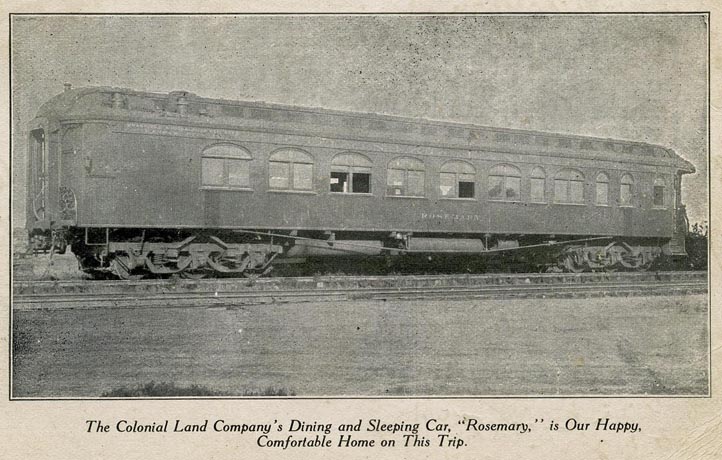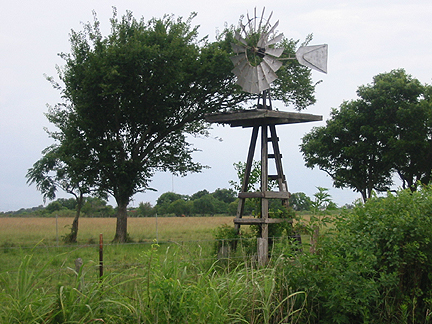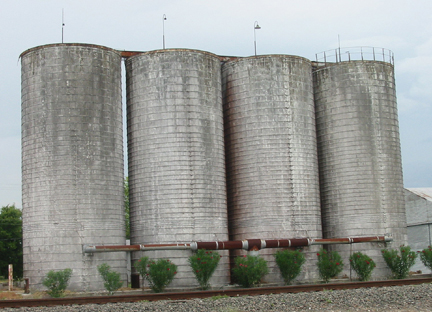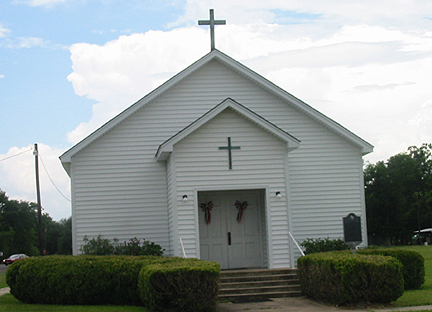|
WADSWORTH INFORMATION |
||
 The Colonial Land Company's Dining and Sleeping Car, "Rosemary," is Our Happy, Comfortable Home on This Trip Ambrose A. Plotner and John W. Stoddard, founders of Wadsworth, formed the Colonial Land Company after purchasing the Kemp Pasture in 1902 |
||
|
||
|
||
|
Wadsworth By Betty M. Seerden
Wadsworth is situated south of Bay City on State Highway 60, midway between Bay City and Matagorda. It is an area owned primarily by farmers and ranchers.
In the early 1900’s land speculators from the northern states were buying land to develop and resell as a means of financial advancement. John W. Stoddard and A. A. Plotner, from Dayton, Montgomery County, Ohio, purchased the lands called the “Kemp Pasture,” October 11, 1902. The following transaction was entered in the Deed Records of Matagorda County, Book 19, Page 397: Mrs. Wilhelminia Kemp, widow of the late John Kemp Sr., and Josephine Kemp, spinster (daughter of the said John Kemp Sr., deceased) formerly residents of Matagorda County, but now residing in the city of San Antonio; for $87,356.92 to be paid in yearly notes at 7 percent interest by A. A. Plotner and John W. Stoddard; to be completed by April 11, 1907. Seven certain tracts of land composing what is known as the Kemp Pasture lands totaling 6,239.72/100 acres on the waters of Peyton's Creek and Big Boggy Bayou, tributaries of Matagorda Bay, about 10 miles south of Bay City.
Plotner and Stoddard created the Colonial Land Company and were wise in their promotions to have a railroad through the area. A document filed August 11, 1903, and entered in the Deed Records of Matagorda County, Book 11, Page 615, shows the conveyance of a 100-foot right-of-way to the Cane Belt Railroad for the sum of $1 with the stipulation that a spur of siding sufficient in length to accommodate such cars as may be necessary to transport freight to and from said points, be created on this land.
In 1902 the railroad was extended south from Bay City to Matagorda. The railroad was vital to the area for the transportation of cattle, grain, shell, and sulphur. The Santa Fe built a depot in Wadsworth.
During 1909 a Mr. Barnes was one of the agents employed by the land company to interest northerners in settling the area. The townsite was platted, a map produced, and lots advertised for sale. Three of the sales were: March, 1910, to Joseph Butter, Lots 1 and 2, Block 28, $300; May, 1910, to William C. Reling, Lots 11 and 12, Block 38, $100; and June, 1910, to Henry Mahavier, Lot 2, Block 27, $100.
The town of Wadsworth received its name from the Wadsworth family. In 1838 Albert Wadsworth, a twenty-five-year-old sailor, came to Matagorda from North Carolina and became a merchant. He married Catherine Mackey, and after she died, he married her sister, Mary Mackey. Of these two marriages three sons, William Bryant, Thomas Mackey, and Edward, and five daughters, Catherine, Mary, Ruth, Sarah, and Alberta, were born.
The parents, Albert and Mary Wadsworth, died in 1862 of yellow fever and were buried at Matagorda. Thomas Mackey Wadsworth was one of the soldiers who froze to death in the Matagorda Bay incident. Edward, who never married, died in 1916. Ruth died at age sixteen. Catherine married Dr. James Thompson; she died in 1865. Mary, Sarah, and Alberta married and moved to central Texas. Only William Bryant Wadsworth remained in Matagorda County. He married Julia Hodges, and their son was Albert Hodges Wadsworth.
William Bryant Wadsworth was called “Matagorda’s grand old man.” He owned a large farm east of the Wadsworth townsite and his son, Albert, inherited the farm.
A two-story structure, built by Zepplick Butter, situated on the east side of the railroad tracks and on the south side of the business street, housed the first business in Wadsworth. There was a pool hall on the ground floor with a rooming house above. In 1912 Butter erected another building of the same size which was used as a hotel until 1923. It stood vacant until 1932 when Frank Culver bought the building for the wood. During the hotel’s heyday, one could get a hot bath for 25¢, and the community used the lower floor for their meetings and celebrations.
Christian Zipprian moved his general store from Rymers Switch to the new townsite, and he became Wadsworth’s first postmaster. Rymers Switch, situated about one mile north of the Wadsworth townsite, was a siding on the Sante Fe Railroad.
Albert Wadsworth owned the Wadsworth Bank and he had a grocery store in the same building. Robert “Bob” Ware Benge was president of the bank. Benge came to Matagorda County in 1895 as a child. He died in Bay City on March 11, 1974, at age 88. The Wadsworth Bank and grocery were in the original Zipprian building which also served as the post office. Charles E. Gibson was postmaster in 1912, and he also operated the grocery store. The bank closed in the 1920’s.
Jack Ellerkamp owned a café and meat market. J. J. Seerden and his partner, a Mr. Blair, onwed a meat market and feed store. A Mr. Shipman managed a lumber yard for the Alamo Lumber Company.
John Ottis built a rice warehouse in 1913, and his sons expanded the facility in 1942 by adding dryers. The dryers were later sold to a Mr. Seifert and were destroyed by fire in 1976. A cotton gin was built in 1913. In 1927 Jim Rugeley sold the gin to Harvey Estlinbaum who repaired it and installed new machinery. H. M. Seerden leased his blacksmith shop to Felix Grantham and later sold it to Hi Brown. A garage for mechanical repairs was operated by a Mr. Meadows, then by George Fanson, followed by his son, Arnold.
Bruce Woods owned a confectionary shop where ice cream, candy, and soft drinks were served. Grocery stores were owned by Russell Bell, John Culver, and Elton Goodall. Other business were: Helen Loundon’s Café; Bill Pump’s Grocery; Lillian Zernicek’s Grocery; Gates’ Grocery; Layton’s Grocery; and Taylor Dry Goods Store, Harry Taylor, owner. T. D. Otzenhoffer and C. L. Blair were employees in the Lorino Brothers Store, owned by A. B. Lorino. A. M. Longwell, C. E. Hartwell, Walter Calhoun, Eric Laird, and a Mr. Wilson were barbers in Wadsworth.
Ben Wheeler was constable in 1913. Doctors for the community were a Dr. Curtis who lived in Wadsworth and Dr. S. A. Foote who lived in Bay City.
Large ranches in the Wadsworth area were: the Poole Cattle Company owned by T. J. Poole, Jr., and D. K. Poole; the Bay Stock Farm owned by Colonial Land Company with W. H. Ramsey as foreman; the Albert Wadsworth Ranch; the Baer Ranch; and the Hawkins Ranch. Smaller ranches were owned and operated by the Culver, Seerden, Petrucha, Savage, Gilmore, LeTulle, Doss, and Sutherland families.
Farmers in the area were: Albert Wadsworth, who owned a large cotton farm with as many as 72 families working on his farm; John and Joe Ottis and sons, rice farmers; a Mr. Gilmore, rice: V. L. LeTulle, rice and cotton; and a Mr. Bunk, cotton, corn and rice.
Horse racing was a big event around 1910. An area northeast of the townsite was leveled and used for the races. Many bets were placed and some of the people lost heavily. As the event grew a few of the participants engaged in unsportsmanlike conduct going so far as doping the horses. In the 1920’s horse racing was held north of town. Since most families had horses, the racing was an enjoyable challenge to the men, but was opposed by the members of the religious groups.
In 1912 the community erected a two-story building on a lot donated by the Colonial Land Company. Situated southeast of the business area, the building served as a church, recreation hall, and Catholic school. Methodist and Baptist services were held each month. The Catholics worshipped in the St. Francisville Church west of Wadsworth. The two-story building was torn down in the 1920’s and the material used to build the Sacred Heart Catholic Church. The Baptist and Methodist congregations erected their own buildings.
The first school was a one-room school taught by Beulah Goodall. It was situated just east of the railroad tracks and east of the old cotton gin. From 1913 to 1917, a Catholic school was situated southeast of the town. One teacher, Carrie Cartwell, taught the primary pupils through tenth grade. The students attending school were: Nell, Bertha, Frank, Clara, and Murray Seerden; Annie, Frank, George, Helen, Emil, Joe and Fred Ottis; Johnny George, and Henry Bunk; Johnny, George, and Mamie Butter; Lula, Zula, Sam, Camel, and Lillian Jamison; Kelly, Matt, and Helen Ottis; Ida, Regina, and Josephine Petrucha; Josie and Maggie Seerden; Lee, Tony, and Marie Weber; and Genievieve and Herbert Goodall. When the school closed, Carrie Cartwell returned to her hometown of Dallas and married.
In 1913 the Colonial Land Company donated a block of land for a public school and the school district purchased a block. A two-story building was erected in which first grade through high school students were taught. The huge building had two large classrooms downstairs and one large room with a stage upstairs. One teacher taught several grades in each room. There was no indoor plumbing. Two little outhouses sat along the path, and a water fountain was outside the building. Students took their lunches and ate their “homemade biscuits” at their desk.
In later years the school was changed to a primary school, and secondary students were bussed to Gulf High School in Old Gulf. After the Gulf school closed, the high school students went to Bay City High School. The Wadsworth school was used until the 1940’s, and then all students were bussed to Bay City. The building and property were finally sold.
Sporting events were big in Wadsworth. The high school students had a baseball and a basketball team. The teams played other schools in competition. Funds being limited, the parents purchased uniforms for the children and provided as much equipment as possible.
The year 1913 was not a good one for Wadsworth’s 300 residents. A big fire destroyed several establishments on the north side of the business street. The fire, which began as a grease fire in the café, destroyed the café, a grocery store, and a feed store. The 1913 flood caused the Colorado and Brazos rivers to become one, resulting in the loss of animals and property. That same year, many mules, horses, and cattle were lost in the anthrax epidemic.
There were good times, too. In February, 1913, Plotner and Stoddard employed a Mr. Gori of Markham to work on the streets. With his mules, Gori graded the streets and completed the drainage. That was a big event for the town, and families from the surrounding area brought their children to watch the operation.
It is interesting to note an article written by a resident of Wadsworth that appeared in the Daily Tribune, February 6, 1914:
We want the world to know that Wadsworth is a progressive town along the line of morality and religion as well as prosperous financially. Four years ago, the place was a scene of horse racing every Sunday; without a public school or Sunday School, or a single church organization of any kind. Today horse racing is a think of the past and we can boast of two good Sunday Schools and three church organizations. The Catholics have a large Sunday School and preaching services most every Sunday; the Methodists and Baptists have union Sunday school every Sunday and preaching three Sundays out of every month.
In 1928 Matagorda County voted to pave the roads, which were a part of the state highway system. State Highway 60 from Bay City to Matagorda was paved at that time, Previously, travel had been through the mud. Most of the homes in the Wadsworth area received electricity in 1930. Shelled streets also created an outlet to the highway.
Oil leasing and production became quite active.
John Ottis had the only telephone in 1935. A Mr. Kilbride in Matagorda owned a telephone system from Bay City to Matagorda. He later sold out to Southwestern Bell.
Wadsworth had wells for water on an individual basis until 1960 when a water works system was installed for the town.
A fire department was organized in December, 1969. A 1955-model two-ton truck was the first fire engine. The residents of Wadsworth have worked hard to update their equipment and have built a firehouse.
The depression years, the construction of a highway, and the change to automobiles caused a decline in most of the business establishments in Wadsworth. Since the residents had to go into Bay City to bank and shop for feed, hardware, and clothing, they also bought their groceries there. The town of Wadsworth, however, has continued to serve the basic needs of its residents–bread, gas, repairs, and a post office.
In 1986 the following businesses can be found in Wadsworth: Sacred Heart Catholic Church, Wadsworth Baptist Church, United Methodist Church, Wadsworth Fire Department, Country Roads Inn, Morehead Grocery and Trailer Park, Guffey’s Grocery, Country Sno-Cones, Ryman Brothers Garage, United States Post Office, Layton’s Barber Shop, J & J Drive In and Tackle Shop, Jeanette Lee Income Tax Service, Dirty Duds Washateria, and Country Kids Day Care.
Historic Matagorda County, Vol. I, pp. 412-416 Courtesy of Shirley L. Brown
|


